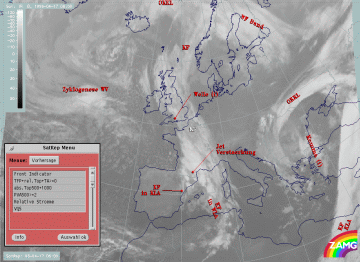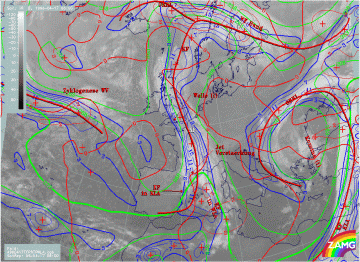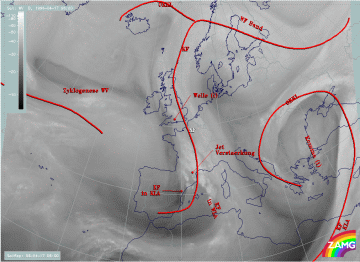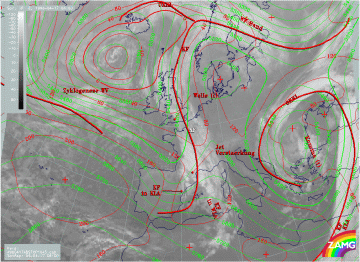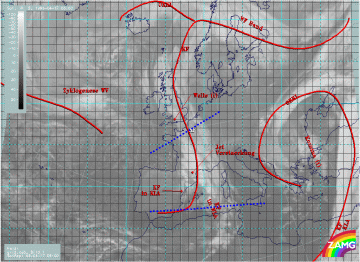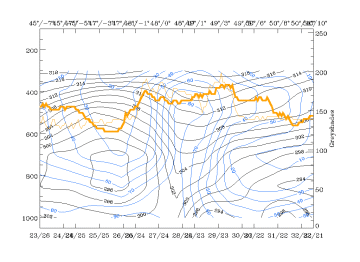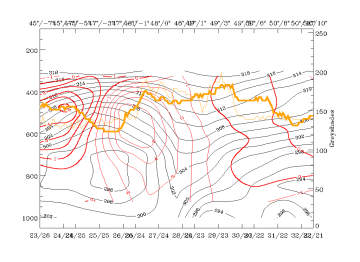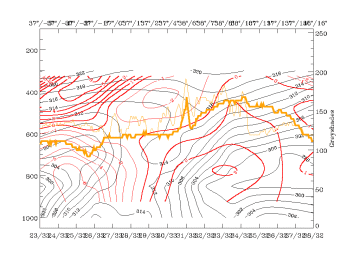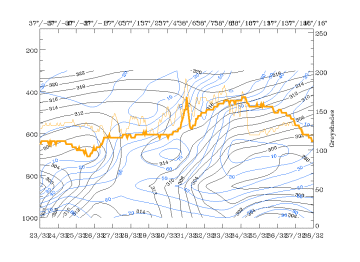17 April 1996 - Cold Front
|
17 April 1996/06.00 UTC - Meteosat IR image; SatRep overlay: names of conceptual models, SatRep menu: key parameters for Cold Front
|
|
For the diagnosis of the Cold Front a couple of key parameters with special thresholds as well as useful combinations of key parameters have been developed (for more information compare also the manual, Conceptual Models: Cold Front ).
| Front Indicator: | This is a line indicating the maximum of the thermal front parameter (TFP) 500/850 hPa (*10-1K m-1) |
|---|---|
| TFP + rel.Top + TA>=0: | This combination contains the thermal front parameter (TFP) 500/850 hPa greater than 3 units, the equivalent thickness (rel.Top) 500/850 hPa (K) and warm advection 500/1000 hPa (TA>=0) (K 12h-1); this parameter combination contains the information about the thermal situation in the area of the Cold Front |
| TFP + Scher300=0: | This is a combination of the thermal front parameter (TFP) 500/850 hPa greater then 3 units and the zero line of shear vorticity at the 300 hPa level (Scher300=0); this combination of key parameters is indicative of the relation between front and jet stream |
| abs.Top500 + abs.Top1000: | This is the combination of height contours at 1000 and 500 hPa (gpm); this combination of key parameters is indicative of the stream and pressure distribution near the surface and in the middle of the troposphere |
| PVA500>=2: | This field shows areas of positive vorticity advection (PVA) at 500 hPa greater than 2 units (*10-9sec-2); this key parameter indicates areas with increased possibility for more severe weather events because of increased vertical motion (compare also Conceptual Models: Wave and Conceptual Models: Front Intensification by Jet Crossing ) |
| Relative Stroeme: | This parameter shows relative streams on isentropic surfaces; relative streams are indicative of the different air masses involved in the process of sinking or rising areas; they can be used to explain cloud configurations requiring special explanation |
| VQS: | Gives the location of available vertical cross sections (VQS) |
|
17 April 1996/06.00 UTC - Meteosat IR image; blue: thermal front parameter (TFP) 500/850 hPa, red thick: front indicator, green:
equivalent thickness 500/850 hPa, red: temperature advection - WA 1000 hPa; SatRep overlay: names of conceptual models
|
17 April 1996/06.00 UTC - Meteosat WV image; red thick: front indicator; SatRep overlay: names of conceptual models
|
The combination of TFP (blue), thickness (green) and TA (red) shows, in an area reaching from France northwards, a quite classical situation with the front locator (thick red line) more to the rearward edge of the cloud band, except for the cloud bulge over the British Isles where it is more on the leading edge. According to the WV image, there is a broad band of high WV values extending over the IR band, especially in the eastern part. A more complicated distribution of relevant parameters can be seen in the Mediterranean with two cyclonically curved cloud bands: the eastern one reaching from south France to Tunisia, and a western, very short one which is along the east coast of Spain. There are also two branches in the TFP field, but the identification especially of the eastern cloud band as Cold or Warm Front is not evident. This area is the subject of one of the "special investigations" and will not be discussed here (compare "Special Investigation": Rapid Cyclogenesis Including Detection of Numerical Model Error).
Equivalent thickness (green) reveals that there is a trough at the rear of the cloud band which is very pronounced but does not show a broad zone of high gradients. Consequently, the change from warm air within the thickness ridge in front of the cloud band to the cold air in the thickness trough behind it is not so well developed in this kind of presentation. Although the zero line of temperature advection (TA) is very close to the frontal edge of the cloud band, there are no pronounced centres of WA and CA.
The situation in the Mediterranean differs from the one described just now with much more distinct gradients in the thickness and a well-developed area of WA. This will be discussed in the special investigation (compare "Special Investigation": Cyclogenesis in the Western Mediterranean Including Detection of Numerical Model Error).
In summary, the frontal cloud band is not accompanied by very distinct transitions of air masses in the layer under discussion (500/850 hPa); reasons for this may be that it is already an old system or that there are distinct differences in the single layers which are averaged in the whole layer. Vertical cross sections which are discussed further below can give an answer to these assumptions.
|
17 April 1996/06.00 UTC - Meteosat IR image; red: height contours 1000 hPa, green: height contours 500 hPa; SatRep overlay: names of
conceptual models
|
17 April 1996/06.00 UTC - Meteosat IR image; red thick: front indicator, yellow: positive vorticity advection (PVA) 500 hPa; SatRep
overlay: names of conceptual models
|
Height charts close to the surface level (red) and at 500 hPa (green) contain unusually sharp troughs at both levels which are shifted in such a way relative to each other that there is a westward inclination with height, a very common situation. The situation is completely different for the cloud area in the Mediterranean and will be discussed in the "special investigation" (compare "Special Investigation": Cyclogenesis in the Western Mediterranean Including Detection of Numerical Model Error).
The yellow lines in the right image represent maxima of positive vorticity advection at 500 hPa (PVA) and accompany the rear side of the frontal cloud band with the main maximum over the Mediterranean part (compare"Special Investigation": Cyclogenesis in the Western Mediterranean Including Detection of Numerical Model Error) and a second maximum immediately south of the cloud bulge. The latter is typical for an ongoing Wave development (compare Wave or Conceptual Models: Wave ).
|
17 April 1996/06.00 UTC - Meteosat IR image; red thick: front indicator, ECMWF grid superimposed; postiion of vertical cross section
indicated, SatRep overlay: names of conceptual models
|
|
There are two vertical cross sections computed: the northern one is between the two cloud systems and should be very characteristic of the type of frontal cloud band under discussion. The southern one should be characteristic of the double structure in the Mediterranean and is shown here only for comparison purposes. For a detailed discussion see the "special investigation" (compare "Special Investigation": Cyclogenesis in the Western Mediterranean Including Detection of Numerical Model Error).
|
17 April 1996/06.00 UTC - Vertical cross section; black: isentropes (ThetaE), blue: relative humidity, orange thin: IR pixel values,
orange thick: WV pixel values
|
17 April 1996/06.00 UTC - Vertical cross section; black: isentropes (ThetaE), red thin: temperature advection - CA, red thick:
temperature advection - WA, orange thin: IR pixel values, orange thick: WV pixel values
|
In contrast to the diagnosis of the frontal cloud band as a Cold Front, the lines of the equivalent potential temperature (black) show a configuration which is very similar to an Occlusion forming a trough, with zones of high gradients on both sides of the trough, minimum and high values of humidity centred around it (blue lines for relative humidity and orange lines for satellite top temperatures in the left panel). This result would confirm the conclusion made above that the system is already an old one and would reject the other possible conclusion of having different states in different layers.
However, there are a lot of reasons which contradict the diagnosis of an Occlusion cloud band:
- The left, Cold Front - like zone of high gradients of isentropes reaches deep down to the earth surface
- There is no warm advection (red in the right cross section) in the area where the isentropes are forming a trough.
But the latter is an absolutely necessary condition for the development of an Occlusion.
Consequently, the conclusion would be that there is a Cold Front in an advanced stage of development, mostly under the influence of CA, with a broad cloud band mostly in front of the Cold Front zone characterized by the isentropes. This Cold Front zone is on top and in front of an unstable air mass centred around 47N/03W which is in the cold, cloud free air behind the frontal cloud band. Because of very dry and cold air which reaches from the top of the troposphere down to approximately 800 hPa no cloudiness develops. The WV imagery shows the dry air as a pronounced black stripe in the area of Brittany.
|
17 April 1996/06.00 UTC - Vertical cross section; black: isentropes (ThetaE), red thin: temperature advection - CA, red thick:
temperature advection - WA, orange thin: IR pixel values, orange thick: WV pixel values
|
17 April 1996/06.00 UTC - Vertical cross section; black: isentropes (ThetaE), blue: relative humidity, orange thin: IR pixel values,
orange thick: WV pixel values
|
The vertical cross sections in the southern part of the cloud band have at first glance some similarities to the northern cross section just discussed. There is an unstable area on the western edge and a Warm Front - like frontal zone in the eastern half of the cross section; but there are also important differences, for instance in the distribution of dry and humid zones, which may lead to the mentioned double structure there and which are discussed in one of the "special investigation" (compare "Special Investigation": Cyclogenesis in the Western Mediterranean Including Detection of Numerical Model Error).
